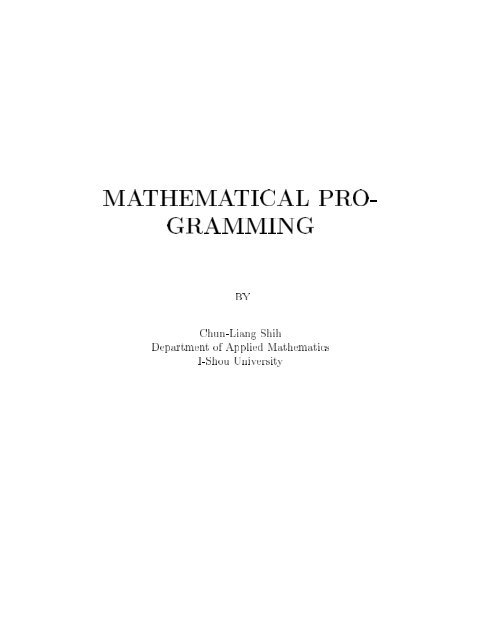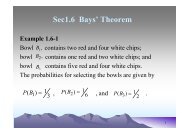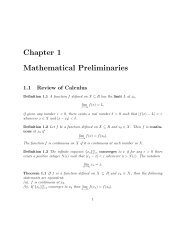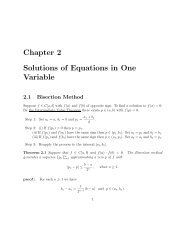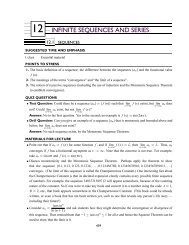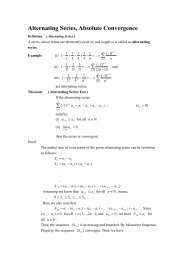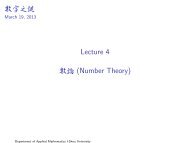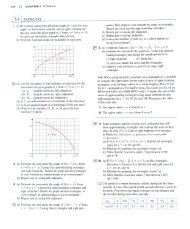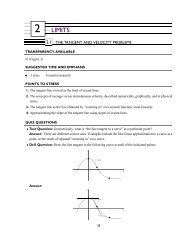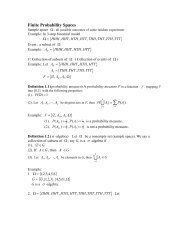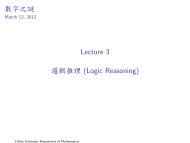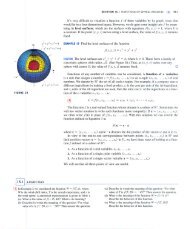C:\Documents and Settings\BabyGator\.TeXmacs\system\tmp
C:\Documents and Settings\BabyGator\.TeXmacs\system\tmp
C:\Documents and Settings\BabyGator\.TeXmacs\system\tmp
Create successful ePaper yourself
Turn your PDF publications into a flip-book with our unique Google optimized e-Paper software.
MATHEMATICALPRO- GRAMMINGChun-LiangShih byDepartmentofAppliedMathematics I-ShouUniversity
Chapter1 Introduction 1.1BasicDenitions<strong>and</strong>Notationsas isworkingonanoptimizationproblem.Ingeneral,everyoptimizationproblemcanbewritten Ifoneisgoingtominimize(ormaximize)afunctionwhileholdingsomeconditions,thenonesubjecttog(x)60 Minimizeh(x)=0f(x)problem. thenwecallthisalinearprogrammingproblem;otherwise,wecallitanonlinearprogramming wheref,g,<strong>and</strong>harefunctions<strong>and</strong>isaset.Ifthefunctionsf,g,<strong>and</strong>harelinearfunctions, x2Considerthefollowingproblem Minimize subjecttoa11x1+a12x2++a1nxn=b1 a21x1+a22x2++a2nxn=b2 c1x1+c2x2++cnxnam1x1+am2x2++amnxn=bm x1;x2;;xn>0 Thisistheproblemtominimizethemultiplevariablesfunctionc1x1++cnxnwithsomeconstraints.Wemaysimplifythisproblemasmins:t:Ax=b x>0 cTxwherec=0@c1 1.cTxiscalledtheobjectivefunction(costfunction). cn1A,x=0@x1 xn1A,b=0@b1 bm1A,A=0B@a11a12a1n am1am2amn a21A22a2n1 CA.3.biscalledtheright-h<strong>and</strong>-sidevector. 4.ThesetR=fxjAx=b;x>0giscalledthefeasibleregionoftheproblem. 2.Aiscalledtheconstraintmatrix.5.Apointx0isfeasiblefortheproblemifx02R;infeasible,otherwise. 3
46.Aconstraintisactiveatthepointx0ifAix0=biwhereAiisthei-throwofthecon-straintmatrixA. Introduction8.Theprobleminiscalledthest<strong>and</strong>ardformofthelinearprogrammingproblem. 7.x0iscalledanoptimalsolutiontotheproblemifx02R<strong>and</strong>cTx06cTxforallx2R.1.2DierentFormsforLinearProgrammingProblemsExample1.1. Linearprogrammingproblemsmayappearinformsthataredierenttothest<strong>and</strong>ardform.Given maxcTxThisproblemisequivalenttotheproblem?min?cTxs:t:Ax=b x>0Example1.2. s:t:Ax=b x>0Given mindTyWemayaddinanonnegativevectorvariablezsuchthatDy+z=e.Inthiscase,Theproblem s:t:Dy6eaboveturnsouttobe y>0min s:t:Dy+z=e y>0 z>0 dTyIfwewritex=yz,c=d0<strong>and</strong>A=?D;I,whereIisanidentitymatrix,thenwehavea st<strong>and</strong>formagain. Example1.3. Given mindTy s:t:Dy=b
1.3GeometricalInterpretationcanrewritetheproblemto ableyasthedierenceoftwononnegativevariables.Thatisy=u?v,whereu;v>0.Thenwe Thereisnononnegativeconditioncomparetothest<strong>and</strong>ardform.Theideaistotakethevari-5mindT(u?v)Nowletx=uv,c=d s:t:D(u?v)=b?d,<strong>and</strong>A=?D;?D,weseeast<strong>and</strong>ardformagain. u>0Thereisanotherformwhichisalsofrequentlyseeninthelinearprogrammingproblems. v>0mincTxItiscalledthecanonicalform. s:t:Ax6b x>01.3GeometricalInterpretation Example1.4. setR. LetR=fxjx262;?x260;?x1+x261;x1+x265;x1>0g.DrawthefeasibleregionfortheExample1.5. Figure1.1.denedinthepreviousexample. ConsideraLPproblemwithobjectivefunctioncTx=?x1?2x2<strong>and</strong>thefeasibleregionRisregion. Remark1.6. Ingeneral,ifaLPproblemhasasolution,thenithasonethatisavertexofthefeasible
6 Introduction1.4ConvexSets<strong>and</strong>ConvexFunctions Denition1.7.ii.Anypointoftheformx+(1?)ywith2[0;1]iscalledaconvexcombinationofx i.AsetX2Rniscalledaconvexset;ifforanytwopointsx<strong>and</strong>yinX,thenx+(1?)y2X <strong>and</strong>y. foreach2[0;1].Example1.8.Denition1.9. representedasastrictconvexcombinationoftwodistinctpointsinthesetX. ApointxinaconvexsetXiscalledanextremepointofthesetXifthepointxcannotbeDenition1.10. x,y2X,2(0;1)impliesx=x=y. LetXbeaconvexset.x2XiscalledanextremepointofthesetXifx=x+(1?)ywithExample1.11. ii.X=f(x1;x2)jx1+x262;?x1+2x262;x1;x2>0g,E=f(0;0);(0;1);(23;43);(2;0)g. i.X=f(x1;x2)jx12+x261g,E=f(x1;x2)jx12+x2=1g.Note1.13. Denition1.12. <strong>and</strong>kisascalar. AhyperplaneHinRnisasetoftheformfxjpTx=kgwherepisanonzerovectorinRniii.Ahyperplaneisaconvexset. ii.SincepTx?k=0,wemayviewitaspT(x?x0)=0.Thatisp?(x?x0)forsomex0. i.pisusuallycalledthenormalorgradienttothehyperplane.Denition1.14. iv.AhyperplanedividesRnintotworegions,calledhalf-spaces,fxjpTx6kg<strong>and</strong>fxjpTx>i.Afunctionf:S!R,whereSisanonemptyconvexsetinRn,isconvexifforanyx,y2 kg.Rn,ii.Forf:S!R,iff(x+(1?)y)
1.4ConvexSets<strong>and</strong>ConvexFunctionsstrictlyconvexfunction. Example1.16. Example1.15.Thefollowingfunctionsareconvex. IfQisasymmetricpositivedenitematrix<strong>and</strong>qisavector,thenf(x)=xTQx+qTxisa7iii.f(x)=x2?2x. ii.f(x)=|x|: i.f(x)=2x+4.convex. Example1.17. iv.f((x1;x2))=2x12+x2?2x1x2.Lemma1.18. Givenf(x)=xTQx,whereQisasymmetricpositivedenitematrix.ShowthatfisstrictlyS=fx2Sjf(x)6g,where2R,isaconvexset. Proof. Letx<strong>and</strong>y2S<strong>and</strong>2(0;1). LetSbeanonemptyconvexsetinRn<strong>and</strong>f:S!Risaconvexfunction.Then,thesetIfx=x+(1?)y,thenbytheassumptionthatSisconvex,wehavex2S. Sincefisconvex,wehave f(x)=f(x+(1?)y) = 6f(x)+(1?)f(y)Thatis,x2S. Hence,Sisconvex. 6+(1?)Denition1.19. i.Apolyhedralsetorpolyhedronistheintersectionofanitenumberofhalf-space. Denition1.20. ii.Aboundedpolyhedralsetiscalledapolytope.ii.Ifmorethanndeninghyperplanespassthroughanextremepoint,thensuchanextreme i.Apointx2XRnissaidtobeanextremepointoracornerpoint,oravertexofXifxiii.Theexcessnumberofplanesoverniscalleditsorderofdegeneracy. pointiscalledadegenerateextremepoint. liesonsomenlinearlyindependentdeninghyperplanesofX.iv.Apolyhedralsetwithatleastonedegenerateextremepointissaidtobeadegeneratepolyhedralset.
Chapter2 SimplexMethod2.1BasicFeasibleSolutionsanm(n?m)matrix. nmatrix<strong>and</strong>b2Rm.Supposethatrank([A;b])=r<strong>and</strong>(A)=m.Wecanrearrangethecolumns ofthematrixAtohaveA=[B;N]insuchawaythatBisanmminvertiblematrix<strong>and</strong>Nis ConsiderthelinearsystemAx=b<strong>and</strong>thenonnegativeconditionx>0,whereAisanmthenonbasicmatrix.ThecomponentsofthevectorxBarecalledbasicvariableswherethecomponentsofthevectorxNarecallednonbasicvariables.fxjAx=b;x>0g.WecalltheinvertiblematrixBthebasicmatrixwherethematrixNiscalled solutiontothesystem.IfxB>0,thenthissolutionxiscalledabasicfeasiblesolutionoftheset Asolutionx=xB xNtothesystemAx=b,wherexB=B?1b<strong>and</strong>xN=0,iscalledabasicExample2.1. Considerthepolyhedralsetdenedbyx1+x266byintroducingtheslackvariablesx3;x4,wecanrewritethissetintost<strong>and</strong>ardform x1;x2>0 x263IfweletthematrixA=1110 x1;x2;x3;x4>0 x1+x2+x3=60101=?B;N,thenwecanabbreviatetheaboveproblemto x2+x4=3Ax=b;x>0. ThefollowingsarepossiblewaysofextractinganinvertiblematrixBfromthematrixA. 2.B=?A1;A4=10 1.B=?A1;A2=11 01,xB=B?1b=10 01,xB=B?1b=1?1 0163=63>0: 0163=3>0:3.B=?A2;A3=11 4.B=?A3;A4=10,xB=B?1b=0101,xB=B?1b=10 1?163=3>0:5.B=?A2;A4=10 11,xB=B?1b=10 ?1163=6 0163=63>0:9 ?30:
10Hence,wehavefourbasicfeasiblesolutionstothisconstraintregion,namely x=0B@30 1 CA;0B@603 1 CA;0B@030 1 CA;0B@063 1 SimplexMethodCA:Wemayshowtheresultsina2-DspaceasTheorem2.2.TheFundamentalTheoremofLinearProgramming Foraconsistentlinearprograminitsst<strong>and</strong>ardform Figure2.1.mincTxwithafeasibledomainP,theminimumobjectivefunctionvalueofcTxoverPiseither s:t:Ax=bunboundedbeloworisachievableatleastatoneextremepointofthefeasibledomainP. x>02.2TheSimplexMethod ConsiderthefollowinglinearprogrammingproblemwhereA2Rmnwithrankm. s:t:Ax=b mincTxtionasx=xB;xNTwithxB=B?1b>0<strong>and</strong>xN=0.IfapointxsatisfyingAx=b<strong>and</strong>x>0, Supposewehaveabasicfeasiblesolutionxtothisproblem,thenwemaywritethissolu-x>0tionswemaywrite thenwemaydecomposexinto?xB;xNTaccordingtothematricesB<strong>and</strong>N.Usethesenota-)?B;N=b)BxB+NxN=bAx ) =b?NxN =B?1b?B?1NxN
SubstitutethisxBintotheobjectivefunctioncTx,wehave 2.2TheSimplexMethod 11cTx=cBTxB+cNTxN=cTx?(cBTB?1N?cNT)xN =cTx+(cNT?cBTB?1N)xN =cBTB?1b+(cNT?cBTB?1N)xN =cBT(B?1b?B?1NxN)+cNTxNx,thismeansthatxisanoptimalextremepoint. If(cBTB?1N?cNT)60,thenwehave(cNT?cBTB?1N)xN>0(sincexN>0).Forarbitrary (2.1)positive,saythej-thcomponentof(cBTB?1N?cNT)ispositive,thenthismeansthatwemay ndavectorxsuchthatcTx6cTx. Considerx=x+dj,wheredj= Ontheotherh<strong>and</strong>,if(cBTB?1N?cNT)0,thatis,somecomponentsof(cBTB?1N?cNT)areThisshowsthatcTx0. equation(2.1),cTx=cTx+(cj?cBTB?1Aj),whereAjisthej-thcolumnofthematrixN. ?B?1Aj ej !withej=?0;;0;1;0;;0T2Rn?m.Thenfromthiscase,wemaychooseanyxwithunboundedstepsize>0,thiswilldrivethecostfunction downtounboundedbelow. CaseI:IfB?1Aj60,theobjectivefunctionvalueisunbounded.Thereasonisthatunder Wenowconsiderthefollowingtwocases:CaseII:IfsomecomponentsofB?1Ajarenotnegative,thestepsizecanbechosenasSupposethattheindexisr,thenwehave =min 16i6mf(B?1b)ix=x+dj (B?1Aj)ij(B?1Aj)i>0g (2.2)=xB =B?1b xN+ ?B?1Aj!Updatethecorrespondingbasic<strong>and</strong>nonbasicmatrices,thiswillleadtoanew 0+ ?B?1Aj ej !AlgorithmforSimplexMethod: Weconcludetheaboveresultsinanalgorithmbelow: pointxwithlowerobjectivefunctionvalue.III.Computethedirectionalvectord= II.Compute(cBTB-1N-cNT).IfcBTB?1N?cNT60,thenstop.Thecurrentbasicfeasiblesolution I.FindabasicfeasiblesolutionxwithbasicmatrixB<strong>and</strong>nonbasicmatrixN.mingproblemisunbounded;Otherwise,computethestepsize<strong>and</strong>updatethecorre-spondingbasic<strong>and</strong>nonbasicmatrices.GotoStepII. ?B?1Aj ej !.IfB?1Aj60,thenthislinearprogram-isoptimal;otherwise,gotoStepIII.Wecanchooseanyoneofthem.Twomostcommonlyusedrulesare Note2.3.ItispossibletohavemorethanonenonbasicvariablewithpositivecBTB?1N?cNT. 2.Largestreductionrule:picktheindexkwiththemostpositivevalue. 1.Smallestindexrule:pickthesmallestindexkfor(cBTB?1N?cNT)k>0:
Example2.4.Givenalinearprogrammingproblem 12 SimplexMethodmin?x1?3x2 s:t:2x1+3x266Thisproblemcanbechangedtothest<strong>and</strong>ardformbyaddingtwoslackvariablesx3<strong>and</strong>x4. ?x1+x261min ?x1?3x2 x1;x2>0s:t:2x1+3x2+x3+0x4=6 Toapplythesimplexmethodonthisproblem,wemayusematrixnotations ?x1+x2+0x3+x4=1A=2310 ?1101;b=61;c=??1;?3;0;0T x1;;x4>0tosimplifythenotationsexpression. i.LetB=10 01=?A3;A4,N=23 xB=B?1b=x3?11=?A1;A2,thenCheckcBTB?1N?cNT=?0010 0123 x4=61<strong>and</strong>xN=x1Usethisindextocomputethedirectionalvectord=0B@01 ?11???1?3=?13.Wechoosej=2. x2=0:determinedby ?31 CA,thenthenewpointisThestepsizeisdeterminedbytheformula(2.2)whichgives=1.Thisleadstoanew x=x+d=0B@061 CA+0B@01 1 ?3 ?1 1 CA:ii.Intherstiteration,the4-thindexischangedfrombasictononbasicwhilethe2nd indexischangedfromnonbasictobasic.Wehavenewbasic<strong>and</strong>nonbasicmatricesasfollows:B=31 withxB=x2 10=?A2;A3<strong>and</strong>N=20 x3=13<strong>and</strong>xN=x1 ?11=?A1;A4pointx=0B@0130 1 CA.From cBTB?1N?cNT=??3;001 1?320 ?11???10 x4=0wechoosethe1stindex.Usethisindextocomputethedirectionalvector =?4?4d=0B@1 ?5 0 1 CAwithB?1A1=?1 5
2.3TheSimplexMethodinTableauFormat Thenewpointwillbe x=x+d =0B@0130 CA+0B@1 ?5 0 1 13CA= 0 B@ 3 5850 with=35.1 CAiii.Intheseconditeration,the3rdindexischangedfrombasictononbasicwhilethe1st indexischangedfromnonbasictobasic.Wehavenewbasic<strong>and</strong>nonbasicmatricesasfollows:From cBTB?1N?cNT=??1;?30@15?3 B=23 ?11=?A1;A2<strong>and</strong>N=1015251A10 501=?A3;A4=?4 5?3 560; 01??00Exercise2.1.ConsidertheLPproblemmin?x1?x2?x3 weknowthatthepreviousiterationhasreachtheoptimalsolution.s:t:2x1+x4=1 x1;;x6>0 2x2+x5=1 2x3+x6=1thisLPproblemcanbechangedto feasiblesolutionxwithbasicmatrixBofthisLPproblem.Then,byaddingavariablez=cTx, Givenalinearprogrammingprobleminst<strong>and</strong>ardform.Supposethatwehaveastartingbasic 2.3TheSimplexMethodinTableauFormatmin s:t:z?cTx=0 Ax=b zSplitthematrixA<strong>and</strong>thevectorxintoA=?B;N<strong>and</strong>x=?xB;xNT,theLPproblemabove turnsouttobe x>0min s:t:z?cBTxB?cNTxN=0 BxB+NxN=b zxB;xN>0 (2.3) (2.4)
Theequation(2.4)canbechangedto 14 SimplexMethodMultiplyequation(2.5)bycB<strong>and</strong>addtoequation(2.3),weget z+0TxB+(cBTB?1N?cNT)xN=cBTB?1b xB+B?1NxN=B?1b (2.5)Equation(2.5)<strong>and</strong>(2.6)canbeexpressedinatableauasxBzxB (2.6)TableauMethodfortheSimplexMethodTable2.1. z0I 10TcBTB?1N?cNTcBTB?1b B?1N xN B?1bRow0 RHSRowsfrom1tomii.MainSteps: i.FindaninitialbasicfeasiblesolutionwithbasicB.FormtheinitialtableauasinTableLet(cBTB?1N?cNT)k=maxf(cBTB?1N?cNT)ig. Otherwise,examinethek-thcolumnofB?1N,sayyk. If(cBTB?1N?cNT)k60,thenstop!Thecurrentsolutionisoptimal; Otherwise,determinetheindexrasfollow: Ifyk60,thenstop!Theoptimalsolutionisunbounded.Updatethetableaubypivotingat(yk)r. Updatethebasic<strong>and</strong>nonbasicvariables. (yk)r=minf(b)i (b)r (yk)ij(yk)i>0gExample2.5.UsethetableaumethodtosolvetheLPproblem Repeatthemainstep.min s:t:2x1+3x2+x3=6 ?x1+x2+x4=1 ?x1?3x2Sol:Firstofall,wecreatetherstTableauaccordingtothegivenLP. x1;;x4>0x3 x411300 02310 0-1101 zx 1x2x3x4RHSTable2.2. 061x3 x21400-3-30501-3 0-1101 zx 1x2x3x4RHSTable2.3. 31
2.3TheSimplexMethodinTableauFormatx1 x2100?401015?3 zx 1x2x3x4RHS5?27 1500115 525 5Table2.4. 3585Tryanotherpath:x3 x411300 02310 0-1101 zx 1x2x3x4RHSTable2.5. 061x1 x41032?10132120 0052121 zx 1x2x3x4RHS 20-3Table2.6. 34x1 x2100?401015?3 00115 zx 1x2x3x4RHS5?275 25 35855Westillgetthesamesolutionx=358500T. Table2.7.Example2.6.UsethetableaumethodtosolvetheLPproblem min s:t:?x1+2x266 x1+x265 x1?3x2Sol:Firstofall,weaddintwoslackvariablesx3<strong>and</strong>x4tomakethersttwoinequalityconstraintsbalanceequations.Followthesameprocesstosetupthersttableau.x1;x2>0x3 x41-1300 0-1210 01101 zx 1x2x3x4RHSTable2.8. 065
16x2 x41120?320 0?1 zx 21 1x2x3x4RHS SimplexMethod0320?121 0 -9Table2.9. 32x2 x1100?43?13?29001 010?1323 zx 1x2x3x4RHS 13 13 1133Theoptimalsolutiontothecostfunction?293whenx1=43<strong>and</strong>x2=11 Table2.10.Example2.7.UsethetableaumethodtosolvetheLPproblem 3.minx1+x2?4x3 s:t:x1+x2+2x39Sol: ?x1+x2+x34 x1+x2?x32 x1;x2;x30x4 x5 x61-1-14000 0112100 011-1010 zx 1x2x3x4x5x6RHS0-111001 0Table2.11. 924x4 x5 x313-5000-4-1603-1010-2 0020011 zx 1x2x3x4x5x6RHS0-111001 Table2.12. 164x1 x5 x310-40-10-2 01-130130?23 002001 zx 1x2x3x4x5x6RHS00231130 13 -17 133 6Theoptimalsolutionis-17whenx1=13,x2=0,x3=133,x4=0,x5=6,x6=0. Table2.13.
2.4StartingSolution 17beforeh<strong>and</strong>.Thisistherequirementtohaveabasicfeasiblesolutionrightaway.However, therstlookofagivenLPproblem. therearesomecaseswemaywanttodiscussbecausesuchamatrixBmightnotbeavailableat Inordertoinitializethesimplexmethod,abasicmatrixBwithB?1b>0mustbeavailableByaddingtheslacksvariablexS,theconstraintsarechangedtothest<strong>and</strong>ardformbelow Supposethattheconstraintsareoftheform Easycase: Axb;x>0;x2Rmn;b>0;b2Rmtionofthissystemisath<strong>and</strong>,bylettingxSbethebasicvector,<strong>and</strong>xbethenonbasicvector. Notethatthenewm(m+n)constraintmatrix?A;Ihasrankm,<strong>and</strong>abasicfeasiblesolu-x>0;xS>0 Ax+xS=bHence,wehaveastartingbasicfeasiblesolutionwithxS=b<strong>and</strong>x=0. Somebadcase: I.SupposethattheconstraintsareoftheformII.Supposethattheconstraintsareoftheform xSviolatesthenonnegativityrequirement. Inthiscase,afterintroducingtheslackvariablexS,wecanNOTjustletx=0,because Axb;x0;butthevectorbisnotnonnegative:AftersubstractingtheslackvectorxS,weget Ax?xS=b;x0;xS0: Axb;x0;whereb0Ingeneral,anylinearprogrammingproblemcanbetransformedintost<strong>and</strong>ardform ?A;?IwithB?1b0. Inthiscase,thereisnoobviouswayofpickingabasicmatrixBfromthematrixmin s:t:Ax=b0 x0 cTx(note:Ifbi
Example2.9.Considerthefollowingconstraints: Note:ThereisnoidentitymatrixforBinthissystem. 18 SimplexMethod?2x1+x2+3x37 x1+x2?2x3?3Multiplythe1stinequalityby-1<strong>and</strong>introducetheslackvariablesx4,x5leadto ?x1?x2+2x3?x4=3 x1;x2;x30Thereisnoidentitymatrixintheconstraintmatrixtoactasthebasicmatrix. ?2x1+x2+3x3+x5=7 x1;;x50matrixinAtoactasthebasicmatrixrightaway,wemayaddinanarticialvectorxaleading tothesystem ConsiderthesystemAx=b,x0,whereA2Rmn,b>0,b2Rm.Ifthereisnoidentity ArticialVariablesHereweforceinanidentitymatrixcorrespondingtothearticialvectorxa.Thisgivesan immediatebasicfeasiblesolutionofthenewsystem,namelyx=0<strong>and</strong>xa=b.However,thisis notabasicfeasiblesolutiontotheoriginalproblem.Inordertogobacktotheoriginalproblem, Ax+xa=b;x0;xa0wemustforcethesearticialvariablestozeros.Thatis,weexpectExample2.10.Considerthefollowingconstraints: Ax=b,Ax+xa=bwithxa=0?3x1+4x25 x1+2x24Introducetheslackvariablesrst,wehave2x1+x26x1+2x2?x3=4 x1;x20?3x1+4x2?x4=5Sincetheconstraintmatrixabovehasnoidentitysubmatrixinside,weaddintwoarticialvariablesx6<strong>and</strong>x7toobtainoneinstantlyẋ1+2x2?x3+x6=42x1+x2+x5=6 x1;;x50?3x1+4x2?x4+x7=5Forthenalsystemabove,wehaveastartingsolutionx1==x4=0,x5=6,x6=4,x7=5. Wewouldliketoforcethearticialvariablesx6<strong>and</strong>x7todropdowntozeros. 2x1+x2+x5=6 x1;;x70Howtondabasicfeasiblesolution?
2.4StartingSolution Wearegoingtointroducetwomethod 19Two-phaseMethod 1.Two-phasemethodWithoutlossofgenerality,wemayasumeb0.Introduceanarticialvariablexa<strong>and</strong>consideranassociatePhaseIproblemasbelowmin s:t:Ax+xa=b Xi=1 mxia2.Big-Mmethodwherexa=?x1a;x2a;;xmaT. Obviously,?x;xa=?0;b0isabasicfeasiblesolutiontotheabovePhaseIproblem.If, xa0 x0byapplyingthesimplexmethodtothePhaseIproblem,wegetasolutionx=x aretwopossiblecases. I.Ifxa0,thentheoriginalproblemisinfeasible,sinceiftheoriginalproblemhasafeasiblesolution,thenx0isalsofeasibleinthePhaseIproblem,whichgivesazeroobjectivefunctionvalue.Thisviolatestheoptimalityofthesolutionxxa.xa,thentherePhaseIproblem II.Ifxa=0,thenwereachanoptimalsolution. min s:t:Ax+xa=b x;xa0 1TxaPhaseIIproblem min s:t:xB+B?1NxN=B?1b cBTxB+cNTxN xB;xN0Example2.11.UseTwo-phasemethodtosolvethefollowingLPproblem min s:t: ?x1+x21 x1+x22 x1?2x2x1;x20 x23
20 Sol: Afterintroducingtheslackvariablesx3,x4,<strong>and</strong>x5,wehavethefollowingsystemSimplexMethodmin s:t: ?x1+x2?x4=1 x1+x2?x3=2 x1?2x2Aninitialidentitymatrixisnotavailable.Soweintroducetwoarticialvariablesx6<strong>and</strong>x7. ThisleadstothefollowingphaseIproblembelow x1;;x50 x2+x5=3min s:t: ?x1+x2?x4+x7=1 x1+x2?x3+x6=2 x6+x7x1;;x70 x2+x5=3 (PhaseI)x6 x7 x51000 011?1001 1?110?100 zx 1x2x3x4x5x6x7RHS 00?1?10Accordingtothest<strong>and</strong>ardsetupfortableaumethod,thecostcoecientscorrespondingtoxB 0010 010 10 2mustbezeros.Tofullllthiscondition,weaddrow1<strong>and</strong>row2torow0<strong>and</strong>getthefollowing 1tableau. 3x6 x7 x5102?1?1000 011?10010 0?110?1001 zx 1x2x3x4x5x6x7RHS0010 0100 213x6 x2 x5120?1100?21020?1101?11 0?110?1001 zx 1x2x3x4x5x6x7RHSzx1x2x3x4x5x6x7RHS 0100 110?121100 010?1212 001?12?120 0 0 0?1?10 12?12 012000 12 12 1?12?12 ablesx6<strong>and</strong>x7areforceddowntozeros.ThisnishthePhaseIproblem<strong>and</strong>wegetabasic Fromtheabovetableauwereachasolutionx1=12,x2=32,x5=32.Theadd-inarticialvari-back,wesetupthePhaseIIproblemasfollow feasiblesolutionfortheoriginalproblem. Deletethecolumnscorrespondingtothearticialvariables<strong>and</strong>replacethecostfunction
2.4StartingSolution1?12 zx1x2x3x4x5RHS 21010?1212 001?12?120 0 0 0 01200012 12 1 dardtableau.Multiplyrow1<strong>and</strong>row2by1<strong>and</strong>-2respectively,thenaddthemtorow0. SimilartothecaseinPhaseIproblem,wehavetosetupthetableauaccordingtothestan-32100 010?1212 zx1x2x3x4x5RHS 12 32 001?12?1200?520 12 000 12 12 1 zx1x2x3x4x5RHS 32 1?30200?4 020?110 011?100 0?10101 zx1x2x3x4x5RHS1?1000?2?6 1Optimalobjectivefunctionsolutionis?6<strong>and</strong>ithappensatx1=0,x2=3. 010011 001001 0?10101 231Example2.12.(Emptyfeasibleregion) min?3x1+4x2 s:t: 2x1+3x2>18 x1+x264Sol:Introducetheslackvariablesx3<strong>and</strong>x4.Weget x1;x2>02x1+3x2?x4=18 x1+x2+x3=4Sincethereisnoconvenientbasis,weintroducethearticalvariablex5intothe2ndconstraint. x1;:;x4>0
22PhaseI10000?10 01110 zx1x2x3x4x5RHS SimplexMethod0230?11 1230?1018 zx1x2x3x4x5RHS 0 181?10?3?10 zx1x2x3x4x5RHS 011100 0230?1118 4Sinceallcostcoecientsarelessthanorequaltozeros,wehavereachestheoptimality.But 0111 0?10?3?11 00 thearticalvariablex5=6>0,weconcludethattheoriginalproblemhasnofeasiblesolution. 46Exercise2.2.Solvethefollowingproblembythetwo-phasemethod. min s:t:2x1+x2+x33 x1+3x2?x3Big-MMethod ?x1+5x2+x34 ?x1+x22Considerthelpproblem(p) mincTx x1;x2;x30Ifthereisnoconvenientbasis,wecanconsiderthefollowingproblem(*) s:t:Ax=b;b0mincTx+M1Txa x0whereMisalargepositivenumber<strong>and</strong>xaisthearticalvariablesvector. s:t:Ax+xa=bTheBig-Mmethodsolvetheaboveproblem(*)withapenalty.Inordertoreducethevalue x;xa0oftheobjectivefunction,thesimplexmethodwilltrytomovetoabasicfeasiblesolutionwith method,oneofthefollowingtwocasesmayarise. xa=0.Theproblem(*)startsfromx=0,xa=b,whilesolvingtheproblembythesimplexCaseI:FiniteOptimalSolution 1.Wearriveatanoptimalsolutionof(*). 2.Weconcludethattheproblem(*)hasanunboundedsolution.ii.xa0 i.xa=0 solutiontotheproblem(p). Ifx;xa)=(x;xa)isanoptimalsolutionto(*)withxa0,thenthereexistsnofeasiblesolutiontotheproblem(p).If(x;xa)=(x;0)isanoptimalsolutionoftheproblem(*),thenx=xisanoptimal
2.4StartingSolution CaseII:Unboundedsolutionof(*)Example2.13.UsetheBig-Mmethodtosolvethefollowingproblem. ii.Atleastonearticialvariableispositive,thentheproblem(p)isinfeasible. i.Allarticalvariablesareequaltozeros,theproblem(p)isunboundedbelow. 23min s:t:x1+x22 ?x1+x21 x1?2x2Sol: SetupthetableauofthisproblemusingtheBig-Mmethod x1;x2;x30 x231?120 011?100 0?110?10 zx1x2x3x4x5x6 00?M?M0 1 x7RHSAddrow1<strong>and</strong>row2torow0tosetuptheabovetableaureadyforthesimplexmethod. 0010 0 10 21zx1 x2 x3 x4x5x6x7RHS 31?12+2M?M?M0003Mz x1 01 0?1 x2x3 1 x4 0 ?1001 x5x6 0 010 x7 211+2M0?M2+M00?2?2M?2+M 12 0?1 01 3?1 1 ?1 00 1 RHS0zx1x2x3x4x5 1 0 0 1 10 x6 x7 RHS100 12 32 0?12?M?32?M?5212010?1212 001?12?1200 000 12 1 1 ?12 130200?2?M?M?4 zx1x2x3x4x5 x6 x7RHS32020?110 011?100 0?10101 zx1x2x3x4x5x6 1 x7RHS0 1?1000?2?M?M?62010011 21Wereachthesamesolutionderivedfromthetwo-phasemethod. 001001 0?10101?1 0 0 31
Chapter3 DualproblemTheorem3.1.(Farka'sLemma) 3.1Farka'sLemma<strong>and</strong>theOptimalConditions One<strong>and</strong>onlyoneofthefollowingtwoproblemshasasolution System1:System2:whereAisagivenmnmatrix<strong>and</strong>cisagivenvector. cTx
Note3.5.Thevectorsu<strong>and</strong>varecalledtheLagrangianmultiplierscorrespondingtotheconstraintsAxb<strong>and</strong>x0respectively.26 DualproblemCorollary3.6.x0isanoptimalsolutionfortheproblemfmincTxjAx=b;x0gif<strong>and</strong>onlyif thereexistsvectorsu<strong>and</strong>vsuchthatthefollowingthreeconditionsaretrue:iii.vTx0=0. ii.c?ATu?v=0,v0. i.Ax0=b,x00.Proof. Exercise3.1.Considertheproblem min?x1?3x2 s:t:x1?2x2?4 wecanusetheKKTconditionstocheckeachbasicfeasiblesolution(x1;x2)=(0;0);(0;2);(4;0);(43;83)ofthe aboveproblem. ?x1?x2?4Sincenoneofthosetwoconstraintsarebindingat(0;0),wemusthaveu=(u1;u2)T=(0;0)T.Thedual Isthebasicfeasiblesolution(0;0)anoptimalsolution? x1;x20optimalsolution. feasibilityconditionimpliesthatc=v.Thatisv=(?1;?3)T
3.2DualityProof. siblesolutionforthedualproblemfmax?bTwjATw=?c;w0g.ThencTx?bTw. LetxbeanyfeasiblesolutionfortheprimalproblemfmincTxjAxbg<strong>and</strong>letwbeanyfea-27=wT(b?Ax)=?wTAx+bTw(wisdualfeasible) cTx+bTwTherefore,wehavecTx?bTw. 0; (Axb;w0)Note3.10.Thistheoremistrueforanyprimal-dualpair. Proof. Corollary3.11. thenx0<strong>and</strong>w0areoptimalsolutionsfortheprimal<strong>and</strong>dualproblems,respectively. Fromtheweak-dualtheorem,wehave Letx0<strong>and</strong>w0befeasiblefortheprimal<strong>and</strong>dualproblems,respectively.IfcTx0=?bTw0,Itfollowsthatx0isoptimalfortheprimalproblem. Similarly, ?bTwcTx0=?bTw0 cTx?bTw0=cTx0impliesthatw0isoptimalforthedualproblem.Theorem3.12.StrongDualityTheorem Proof. forthedualproblem<strong>and</strong>cTx0=?bTw0. Ifx0isanoptimalsolutionfortheprimalproblemfmincTxjAxbg,thentheKKTconditionsgivethatIfx0isanoptimalsolutionfortheprimalproblem,thenthereexistsanoptimalsolutionw0wehave w0T(Ax0?b)=0 c+ATw0=0;w00(2) Ax0b (3) (1)Thisnishtheproof. (2))cTx0=?w0TAx0=?w0Tb=?bTw0 (3))w0TAx0=w0Tbprimalproblem<strong>and</strong>cTx0=?bTw0. Theorem3.13.ConverseDualityTheorem Ifw0isanoptimalsolutionforthedualproblem,thereexistsanoptimalsolutionx0forthe Theorem3.14.FundamentalTheoremofDuality
statementsistrue. 28Withregardtotheprimal<strong>and</strong>duallinearprogrammingproblems,exactlyoneofthefollowingDualproblemiii.Bothproblemsareinfeasible. ii.Oneproblemhasunboundedobjectivevalue,inwhichcasetheotherproblemmustbe i.Bothpossesoptimalsolutionsx<strong>and</strong>wwithcTx=?bTw. infeasible.fori<strong>and</strong>jwehave canonicalform,anecessary<strong>and</strong>sucientconditionthattheybothbeoptimalsolutionsisthat Theorem3.15.ComplementarySlacknessTheorem Letx<strong>and</strong>wbefeasiblesolutionsfortheprimal<strong>and</strong>dualproblems,respectively.Intheiii.wj>0)Ajx=bj. ii.wTAi0)wTAi=ci:iv.Ajx>bj)wj=0.TheDualSimplexMethod whereAiisthei-thcolumnofAwhereAjisthej-throwofA.eachiterationwemovefromabasicfeasiblesolutionofthedualproblemtoanimprovedbasic feasiblesolutionuntiloptimalityofthedual(<strong>and</strong>alsotheprimal)isreached,orelseuntilwe concludethatthedualisunbounded<strong>and</strong>thattheprimalisinfeasible. Thedualsimplexmethodsolvesthedualproblemdirectlyontheprimalsimplextableau.Atthedualtothisproblemis ConsiderthefollowingproblemfmincTxjAx=b;x0g; ThesimplextableauisxBzxB 10TcBTB?1N?cNTcBTB?1b fmaxbTwjATwcg:Atoptimalityoftheprimalminimizationproblem,allthecomponentsonthecostrowmustbe 0I B?1N xN B?1bcostrow RHSlessthanorequaltozeros. thus, i.e. cBTB?1Aj?cj0;forj=1;2;;nIfw=(cBTB?1)T,thenATwc.Thisimpliesthatthedualfeasibilityisholdatthismoment. )AT(cBTB?1)Tc: cBTB?1N?cNT0Tbutsome(B?1b)iarelessthanzeros,wewanttodevelopavariantofthesimplexmethodthat Withthisidea,ifthereisasimplextableaustartingwithdualfeasibility,thatis,wouldproduceaseriesofsimplextableauthatmaintaindualfeasibility<strong>and</strong>complementary slackness<strong>and</strong>stopwhenB?1b0.(i.e.primalfeasibility) cBTB?1Aj?cj0;forj=1;2;;n
3.2Duality SummaryoftheDualSimplexMethod 29Mainsteps: W.L.O.G.AssumecBTB?1Aj?cj0,forallj.II.Ifallthecomponentsinthisrow,denotedasyrj,arepositiveforallj,stop.Thedualis I.IfB?1b0,stop!Thecurrentsolutionisoptimal; unbounded<strong>and</strong>,thus,theprimalisinfeasible; Otherwise,selectthepivotrowrwith(B?1b)r
30x1 zx510?5?3?120?2600?3?2?41?11 01?11?30?13row01x2x3x4x5x6RHS DualproblemSensitivityAnalysis row1Considerthefollowingproblem row2mincTx s:t:Ax=b Wewanttodiscusstheresultsoftheproblemwhensomeofthefollowingconditionsare changed. x0iii.ChnageintheconstraintmatrixA. ii.Chnageintheright-h<strong>and</strong>-sidevectorb. i.Changeinthecostvectorc.ofthischangeonthenaltableauwilloccurinthecostrow. Supposeoneormoreofofthecoecientsincis/arechanged.say,fromcktock0.Theeect ChangeinTheCostVectorcIIfxkisnonbasic: xBzxB 0I 10cBTB?1N?cNTcBTB?1b B?1N xN B?1bcostrow RHStableauischangedfromcBTB?1Ak?cktocBTB?1Ak?ck0,whichis InthiscasecBisnotaected,<strong>and</strong>hencecBTB?1Nisnotchanged.ThecostrowintheSincecBTB?1Ak?ck0,ifthenewresultispositive.i.e. (cBTB?1Ak?ck0)=(cBTB?1Ak?ck)+(ck?ck0)>0 (cBTB?1Ak?ck0)=(cBTB?1Ak?ck)+(ck?ck0)thenxkmustbeintroducedintothebasic<strong>and</strong>thesimplexmethodiscontinue. IIIfckisreplacedbyck0wherexkisbasic. Otherwise,theoldsolutionisstilloptimalw.r.t.thenewproblem.Exercise3.4.Considerthefollowingproblem min?2x1+x2?x3 s:t:x1+x2+x36 ?x1+2x24 x1;x2;x30
3.2Duality Theoptimaltableauisgivenbyx5 zx110?3?1?20?12011 311x2x3x4x5RHSSupposethatc2=1isreplacedbyc20=?3: 003 1 1110 6Sincex2isnonbasic,wecheck cBTB?1A2?c20=(cBTB?1A2?c2)+(c2?c20)wemustrestartthesimplextrableau. =1 >0 =?3+4x5 zx1101?1?20?120111 0031 1x2x3x4x5RHSzx11110 6x2100?4/3?7/3?1/3?46/30102/3 0011/3 zx 1x2x3 2/3?1/38/3x4 x5 RHSExercise3.5.Considertheproblem minx1+x2?4x3 10/3s:t:x1+x2+2x39Theoptimaltableauisgivenbelow ?x1+x2+x34 x1+x2?x32x1;x2;x30x5zx1x2x3x4x5x6RHSx310?40?10?2?17Ifc2=1isreplacedbyc20=3,thensincex2isnonbasic,wecheck 01?1/301/30?2/31/3002/311/301/313/3 2 001 1 6cBTB?1A2?c20=(cBTB?1A2?c2)+(c2?c20)Theoriginaloptimalsolutionisstilloptmal.


